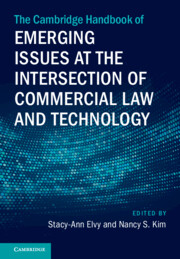Book contents
- The Cambridge Handbook of Emerging Issues at the Intersection of Commercial Law and Technology
- The Cambridge Handbook of Emerging Issues at the Intersection of Commercial Law and Technology
- Copyright page
- Epigraph
- Contents
- Figures
- Tables
- Contributors
- Preface
- Acknowledgments
- Part I Contemporary Technological Developments
- 1 Non-fungible Tokens in Commercial Transactions
- 2 The Challenges of Technological Property
- 3 Regulation under the EU Artificial Intelligence Act
- 4 Blockchain and the Uniform Commercial Code
- 5 Can Technology Foster Price Transparency in Credit Card Processing Markets?
- 6 Quantum Privacy
- 7 Give It Back
- Part II The Implications of Emerging Product Design and Business Models
- Part III Contracting and Dispute Resolution
- Index
3 - Regulation under the EU Artificial Intelligence Act
Too Much, Too Little, Too Late?
from Part I - Contemporary Technological Developments
Published online by Cambridge University Press: 08 February 2025
- The Cambridge Handbook of Emerging Issues at the Intersection of Commercial Law and Technology
- The Cambridge Handbook of Emerging Issues at the Intersection of Commercial Law and Technology
- Copyright page
- Epigraph
- Contents
- Figures
- Tables
- Contributors
- Preface
- Acknowledgments
- Part I Contemporary Technological Developments
- 1 Non-fungible Tokens in Commercial Transactions
- 2 The Challenges of Technological Property
- 3 Regulation under the EU Artificial Intelligence Act
- 4 Blockchain and the Uniform Commercial Code
- 5 Can Technology Foster Price Transparency in Credit Card Processing Markets?
- 6 Quantum Privacy
- 7 Give It Back
- Part II The Implications of Emerging Product Design and Business Models
- Part III Contracting and Dispute Resolution
- Index
Summary
The transformative impact of artificial intelligence (AI) across various sectors, with recent advancements, such as the release of the generative AI model GPT-4, raises critical legal and policy concerns. These concerns include important societal and potentially existential impacts: Threats to democracy, workforce displacement, copyright challenges, environmental effects, new and more lethal cybersecurity threat vectors, and the potential for AI advanced to become uncontrollable or be used for malicious purposes if it falls into the wrong hands. Human rights concerns are also implicated, including the potential for biased and discriminatory decision-making, unreasonable privacy impacts, inaccurate and unfair outcomes, and lack of transparency and due process. The unveiling of GPT-4 emphasizes the need for legislation to address these issues. The European Union (EU) has taken a global lead by enacting the Artificial Intelligence Act (AIA) to regulate AI development, placement, and use, and by proposing the AI Liability Directive (AILD), which aims to facilitate civil claims for damages arising from AI products and services. The AIA takes a comprehensive, risk-based approach to regulating AI across sectors. Significant differences had to be negotiated among the EU co-legislators to reach a consensus on the final text of the AIA, such as defining AI systems, regulating foundation models, determining bans on specific AI systems, and establishing redress rights for consumers and fundamental rights violations. The chapter explores the global context, the EU legislative approach, the key issues that had to be resolved, and the interaction of the AIA with other EU laws, particularly with the General Data Protection Regulation (GDPR).
- Type
- Chapter
- Information
- The Cambridge Handbook of Emerging Issues at the Intersection of Commercial Law and Technology , pp. 51 - 83Publisher: Cambridge University PressPrint publication year: 2025

